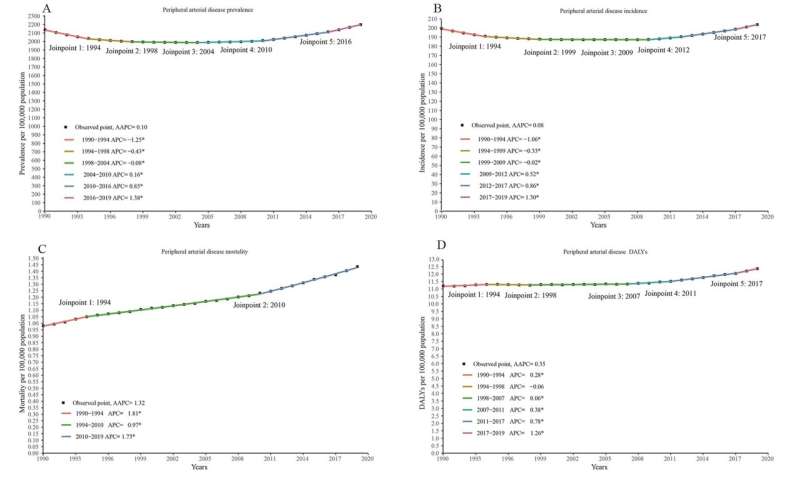This article has been reviewed according to Science X's editorial process and policies. Editors have highlighted the following attributes while ensuring the content's credibility:
fact-checked
proofread
Study analyzes recent global and national trends of atherosclerosis

Cardiovascular diseases are a leading cause of death globally, particularly in the developed countries. Atherosclerosis, which is characterized by a gradual build-up of plaque in the walls of arteries, is a serious cardiovascular condition that can result in ischemic heart disease (IHD), ischemic stroke (IS), and peripheral arterial disease (PAD).
Although the mortality rates of these diseases fell dramatically during the 20th century, the incidence is now ever increasing, placing a significant burden on health care systems. Unfortunately, despite the widespread impact of atherosclerosis, data on the global and national trends of the disease is quite limited.
In a recent effort to address this knowledge gap, a research team from China decided to conduct a detailed statistical analysis on the impact of atherosclerosis at the global and national levels by using GBD data. The study was led by Professor Rongchong Huang and involved other researchers from the Beijing Friendship Hospital of Capital Medical University and the Longyan First Affiliated Hospital of Fujian Medical University.
It was published in the Chinese Medical Journal.
"It is unknown how global changes in pertinent controllable variables in recent years have affected the burden of atherosclerosis," remarks Prof. Huang.
To conduct their analysis, the researchers employed publicly available data from the Global Burden of Disease Study 2019 related to the three main clinical presentations of atherosclerosis, namely IHD, IS, and PAD. The data collected, which spanned the period from 1990 to 2019, included participants of all ages with similar epidemiologic characteristics and in relative proximity, from 21 countries.
Overall, the study had four main goals. The first was to determine the global trends in terms of prevalence, mortality, and disability of the three conditions. The second goal was to identify the years that had the biggest shift in the trends of these indicators. Finally, the third and fourth goals were to analyze global trends based on age, gender, and socioeconomic factors and report global and national patterns, respectively.
According to the results, there was an overall increasing trend in the global incidence of the three clinical manifestations of atherosclerosis from 1990 to 2019. Notably, the main drivers for this rising incidence were adults aged 20–54. The researchers found this very concerning, given that atherosclerosis with such an early onset is usually caused by preventable factors, such as lack of exercise, dietary habits, and environmental pollution.
However, the mortality rates and disability-adjusted life years for IHD and IS declined during this period across all age groups. This could indicate greater awareness regarding these conditions and their early symptoms, as well as advancements in clinical management.
Nonetheless, the global rise in the incidence of atherosclerosis over the past three decades is a serious problem that warrants special attention towards its root causes.
In this regard, Prof. Huang explains, "This rise can be attributed to a variety of factors. Firstly, global aging trends have led to a higher prevalence of the disease, given that age is a significant risk factor for atherosclerosis. Secondly, modern lifestyle habits, including high-fat diets, lack of exercise, smoking, and excessive alcohol consumption, have increased atherosclerosis risk. Lastly, there has been a rise in chronic diseases such as diabetes and hypertension, which are significant risk factors for atherosclerosis."
The researchers also pointed out that the burden posed by atherosclerosis is increasing significantly in low- or middle-income countries, summarizing key social and economic development indicators. China, which has the world's greatest number of deaths due to cardiovascular diseases, is a prime example of this issue.
Taken together, the study paints a grim picture of global cardiovascular health, which is very concerning. "Overall, the burden of atherosclerosis-related disease is still not significantly decreasing and is even trending upward, especially in low- and middle-income countries and in younger populations," says Prof. Huang, "There is an urgent need for more targeted treatment and management in younger populations and in low-middle and middle-income countries."
More information: Weihua Chen et al, Global and national burden of atherosclerosis from 1990 to 2019: trend analysis based on the Global Burden of Disease Study 2019, Chinese Medical Journal (2023). DOI: 10.1097/CM9.0000000000002839




















